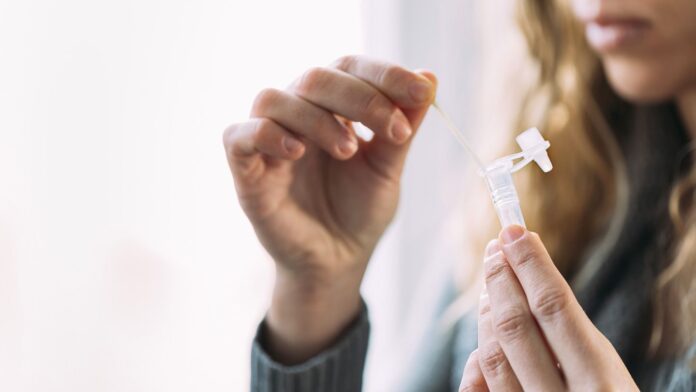It’s the third summer of the pandemic, and by now we know one thing: If you’re traveling, you may need to ponder if, when, where, and how to get a test for COVID-19.
If you’re an American flying to another country, you will need to show proof of a negative COVID-19 test (or documentation of recent recovery from COVID-19) before you can board a plane back to the United States.
Plus you might need or want to get tested for COVID-19 once or multiple times while you’re away. This will depend on where you’re going, what you’re doing, whom you’ll be spending time with, and how you feel day to day.
Generally speaking, the higher the COVID-19 rates at your destination, the more likely testing will be part of your travel experience. With infections once again on the rise in many states and other countries, it’s important to stay informed — and testing-ready.
“A lot of things are changing very quickly,” says David Banach, MD, MPH, a hospital epidemiologist at UConn Health in Farmington, Connecticut. “I think the key is to be alert to what’s happening right before you travel.”
Here, doctors and other expert sources offer advice on how and when to test, and how to keep yourself and those around you safe no matter where you travel.
1. Well Before You Leave Home, Get Up to Speed on Your Destination
Especially for international travel, you’ll want to do your research to learn the latest COVID-19 entry regulations and figure out a strategy.
Many countries, such as England and Mexico, currently have no COVID-related entry rules in effect, either involving testing or vaccination.
But if you plan to travel to France from the United States and are unvaccinated, you’ll need to show proof of either a negative PCR test taken less than 72 hours before departure or a negative antigen (rapid) test administered less than 48 hours prior to your flight.
The only way to get out of this testing requirement is to show documentation of recent recovery from COVID-19 or of a medical exemption from vaccination.
2. Rules or No Rules, Consider Testing Before You Travel
Regardless of the regulations at your destination, “Generally a cautious approach would be to test before traveling,” says Dr. Banach.
The CDC advises anyone traveling within the United States or internationally to “consider getting tested as close to the time of departure as possible (no more than three days) before your trip.”
Should you get a PCR test, or is an antigen test or at-home test just as good? “The increased sensitivity of the PCR test provides a higher level of reassurance,” says Banach.
3. Pack At-Home Tests in Case You Start Feeling Sick While You’re Away
Bring a stash of at-home testing kits with you so it’s more convenient to do a quick check during your trip. “When you travel, if you develop any symptoms, you’ll want to have ready access to tests,” says Luis Ostrosky, MD, the chief of infectious diseases with UTHealth Houston and Memorial Hermann-Texas Medical Center.
“You should definitely test when you have the slightest symptoms,” he adds. “I can’t tell you how many times I’ve heard, ‘I thought it was just allergies.’”
He explains that FDA-authorized at-home test kits are good at detecting COVID-19 in people who have symptoms, such as sore throat or cough. If your at-home test is positive, you’ve got COVID-19.
There is a higher chance of false negatives with at-home kits, meaning your test result tells you that you are not infected when in fact you are. Don’t let a negative result from a single at-home test give you a false sense of security, Dr. Ostrosky emphasizes.
To increase accuracy, “We recommend retesting a couple of times,” he says. That’s why kits generally contain two tests, to be used 24 to 48 hours apart.
4. Find Out Where You Can Get a PCR Test at Your Destination
If you’re experiencing symptoms but test negative on multiple home tests, it’s best to get a PCR test too.
Plus, if you’re feeling perfectly fine but want to be sure you’re infection-free — because you’re planning to spend time with an elderly person at risk of severe COVID-19, for instance — you may want to get a PCR test on top of taking other precautions like masking.
For domestic travelers, the Centers for Disease Control and Prevention (CDC) site can point you to a testing location near you anywhere in the United States.
If you’re traveling internationally, you might want to do some digging ahead of time. A quick internet search may be all you need to find a PCR testing site, or the staff at your hotel might be able to point you to a local hospital, urgent care center, or other testing location.
Make sure to find out if your insurance will cover the test, or expect to pay out of pocket.
5. If You’re an American Traveling Abroad, Be Prepared to Test Before Boarding Your Flight Home
Anyone flying home to the United States from a different country needs to show a negative test taken no more than one day before departure, or proof of recent recovery from COVID-19; check the CDC site for more info.
In many international destinations, local pharmacies administer antigen tests and provide the documentation you’ll need for the airline. Airports may also offer tests, but factor in time in case you have to wait in line.
As another option, you can use an at-home test linked to telehealth services. With these types of tests, a proctor watches over a video call while you test yourself; you then receive proof of the result via an app.
This is the only type of self-test that meets CDC requirements for reentry to the States, so you might want to pack one in your luggage and download the app before departing on your trip.
Among the most widely used choices are Abbott’s BinaxNOW home tests paired with telehealth services by eMed (note: Everyday Health’s chief health and medical editor, Patrice Harris, MD, FAPA, is eMed’s cofounder and CEO) and Ellume home tests accompanied by video supervision from Azova.
6. Consider Whether You Should Test Again on Arrival Home
Should you test when you get back from your trip? The CDC recommends you do so in certain scenarios, even if you don’t have symptoms (as long as you haven’t had COVID-19 in the past 90 days).
“Get tested after travel if your trip involved situations with greater risk of exposure, such as being in crowded places while not wearing a well-fitting mask or respirator,” the agency advises.
You also want to think about what you’ll be doing once you’re home, and the likelihood that if you’re infected you might spread the virus to other people. “Will you be engaging in group activities? With others at higher risk? There are a lot of factors,” says Banach.
Note that any infection you may have picked up while in transit could spread to others even before virus levels rise high enough for an at-home or rapid test to detect, so plan your first few days at home accordingly.
7. Practice COVID-19 Safety Throughout Your Trip, and After You Get Home
COVID-19 testing won’t keep you from getting COVID. You still need to practice other key safety measures — including staying up-to-date on your vaccines and boosters, masking, social distancing, and hand hygiene — to help keep yourself safe and lower the risk that you’ll infect others.
Even though airlines no longer require masks, wearing one when you’re in the airport and on the plane is still a smart idea, says Banach: “I think masking during travel, particularly air travel, is still important. I encourage people to wear a high-quality mask during travel, to protect yourself and others who will be on the flight with you. Also, [wear a mask] if you’re using another travel modality, like a train or bus.”
Ostrosky adds, “The airflow in airplanes is excellent and HEPA-filtered. The problem is when you’re sitting right next to someone with COVID — the airflow won’t help you. You should be masking, either with a double surgical mask or with an N95 or KN95, and not remove it at all.”
Says Ostrosky. “The best thing to keep yourself safe is to mask in high-density public settings like airports, airplanes, concerts, amusement parks — indoors or outdoors. And it’s definitely preferable to do outdoor dining versus indoor dining.”
Regardless of where you’re going and how often you plan to test, keep this one tip in mind throughout your trip, says Ostrosky: “Mask, mask, and mask.”










